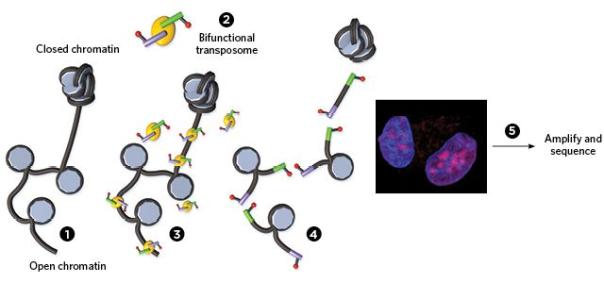In the limited space of the nucleus, the most parts of genome are tightly folded, and only the transcription part is accessible. Howard Chang from Stanford University said, "people have great interest to determine which regions of the genome of a given cell type is active”, which is just the motivation to develop a technology called ATAC-seq (Assay for Transposase-Accessible Chromatin with highthroughput sequencing) by Chang. With ATAC-seq, DNA markers (function as transposon) are integrated into the open regions of the genome by enzymatic reaction, then by sequencing, they are used for the identification of these areas.
Chang described ATAC-seq in 2013, but he said, "We get this information from broken cells, so we can't understand the three-dimensional structure of these accessible genomic regions."
Over the past three years, Chang has developed the ATAC-see technology, also known as assay of transposase-accessible chromatin with visualization. This technology uses the same enzymatic method with ATAC-seq to integrate the DNA markers. Differently, the fluorophores coupled with these DNA markers allow to observe the 3D structure of fixed nucleus visually. Moreover, once these cells are observed, a marked area can be identified by sequencing.
With ATAC-see technology, the Chang team found that unlike most cells, in neutrophils, accessible chromatin tends to appear in the nucleus edge. This distribution seems to promote neutrophil extracellular traps (NET) forming. NET is the important bactericidal weapon of neutrophil. This kind of cell directly spits out its own DNA and histones to form a mesh of traps to catch and kill pathogens. However, NET can also promote cancer metastasis.
The Chang team also uses ATAC-see technology to study how the entire genome's accessibility changes during the cell cycle.
Job Dekker (who was not involved in the study) at University of Massachusetts Medical School said, "One of the major challenges in the field of chromatin research is to integrate the data obtained by genomic and imaging methods together. Therefore, for the detection technology, one of the things I love is that it's a combination of the above two".
| Easily Accessible Chromatin Detection Techniques | Detection Principles | Technical Difficulty | Visualization | The number of cells required for sequencing |
|---|---|---|---|---|
| DNase-seq | DNase I biased digests the accessible DNA. Ligate adapters to these digested DNA chains, and then use these adapters to isolate and sequence these digested regions. | Particularly difficult. Optimized digestion conditions are required. | No | At least of millions |
| ATAC-see | Transposases insert adapters labeled by fluorescent groups into accessible chromatin, and then DNA can be visually observed, amplified and sequenced by using these adapters | For those who are skilled in the standard molecular technology, it is relatively simple. | Yes | 50 thousand. ATAC-seq (lack of fluorescence-labeled visual observation techniques) has detected in a single cell, so the number of required cells may be feasible. |
Related Products and Services in Creative Biogene:



